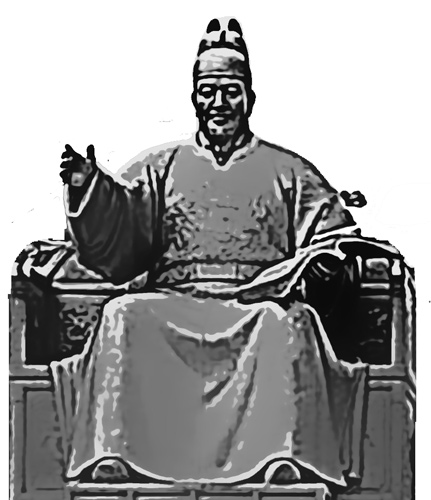Yesterday I began my quick canvas of Korean literature with a discussion of Hyangga and Koryeo Kasa, today that continues with Sijo (perhaps the most popular modern form of Korean Poetry) and Kasa from the Joseon Dynasty..
Sijo and Gasa

King Sejong – Creator of Hangul
During the Joseon period (1392 – 1897) the focus of Korean poetry shifted to the Sijo and Gasa, and this change took place in the company of another epic shift in Korean literature, the introduction and continuing use of Hangul (Hangul was completed in late 1443 or early 1444, and was officially described in 1446 in a document called Hunmin Jeongeum or the “The Proper Sounds for the Education of the People”), the first natively Korean alphabet (see sidebar). Hangul was first regularly used in notating musical scores, but over time spread to more general uses.
The Sijo form was developed in the late Goryeo dynasty, but it was not until the Joseon Dynasty that it came into common use. Themes were often Confucian in nature and focused on the theme of loyalty. Sijo had three stanzas (often expressed in lines) of four feet each and can be compared, in some ways to the Japanese haiku, though the longer form of the Sijo allows greater explication of themes. The form of the Sijo is regular – three lines of 14-16 syllables each with total syllables between 44 and 46. The first line introduces the theme of the Sijo in a 3,4,4,4, syllable structure. The second line elaborates on that theme in a 3,4,4,4 structure. The final line introduces a counter theme in 3 and then 5 syllable feet and concludes with a completing thought or exhortation in a 4 and then 3 syllable foot. A more narrative way of exploring the form notes that a situation is introduced in the first line, explored in the second line, and then given a surprise twist at the outset of the third line, and then concluded by the end of that line. This structure is intended to create an aesthetically ‘complete’ poem that unfolds without hurry.
Sijo was a song, and while it began with the yangban expressing philosophical or religious concerns, its popularity quickly spread among common people as well. With this development of popularity among the masses, the form of the Sijo also began to change, including an increase in its length, with the new form of Sijo being named the p’yong (flat) or changhyong (long form) Sijo. The new Sijo also tended to be lass rarified, often focusing on commonplace emotions and satire.
The following sijo, is said to have been composed by Admiral Yi Sun-sin (The famous “turtle boat” in 1599, on the even of a battle with the Japanese.
Moon-bright night on Hansan Isle,
and I sit alone atop the lookout.
I hold my great sword by my side,
and as my worries deepen,
from somewhere comes the single note of the Mongol flute,
piercing to the very bowels.
(Early Korean Literature, 147)
The Joseon Gasa was free verse, based on a rhythm of doubled feet with three or four syllables. This non-poetic structure has led some critics to consider it a form of essay and not poetry. Gasa themes were mixed, including traditional themes like nature, gentlemanly virtues, and romantic love. The Gasa also often included moral advice (such as the example above) and specific themes including sadness and weariness.
Here is an excerpt from a Gasa by Jon Geuk-in, a poet of the early Joseon Dynasty:
There is between heaven and earth
many a man who’s worth as I.
Why don’t they know the great Joy
Of living in the wooded mountains?
With a grass hut of a few bays
built to face a clear blue stream,
In the lush wood of pine and bamboo
I am the master of wind and moon.The Spirit of Korean 26-한국의 고전 시가(영문) 102
Kasa themes and authors expanded over time, coming to include kasa written by women (내방 가사) and as these expansions occurred, kasa became more quotidian in subject and longer in execution.
NEXT – FICTION!


